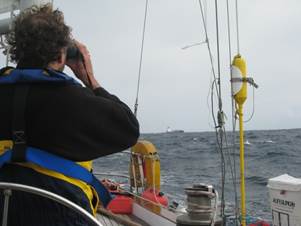|
|
Best practices in watch keeping procedures
- Follow the Vessel's Standard Operating
Procedures (SOP)
Most skippers have rules they adopt for their vessel on passage.
Those rules tell you how often to make entries into the log (e.g., at least
every hour and for every radio contact), under what circumstances to wake
him/her (e.g., change of weather, sail change, gear issues, boat crossing
issues), and safety precautions to take (e.g., STAY ON THE BOAT which means
lifejacket and tether offshore, clipped in before entering cockpit, always
someone else on deck if going forward). It might also include guidelines about
when to run the engine or generator. Ask questions if you are not clear. The
most important thing for the skipper is to know they can trust that you will
alert them if you are not certain of something.
- Get Plenty of Rest
When off
watch, make sure you rest even if you can’t sleep. Short naps just before will
keep you alert longer while on watch. Get a minimum of 6 hours sleep if you
can.
- Wear the Right Gear
Wear
layers for warmth and comfort, always bring foul weather gear with you, and always
wear a life jacket and tether offshore. Clip in to a secure deck fitting before
leaving the cockpit. Consider carrying a personal locator beacon.
- Hydrate and Snack
If you
are prone to seasickness, stay well hydrated and replenish your electrolytes, vitamins
and minerals with supplements. Eat light snacks to maintain
alertness.
- Check the Course and
the Sail Trim
Our
silent crewmembers, the autopilot and wind vane self-steering, are lifesavers
for short-handed crew but they can on occasion be quite mischievous. With a
wind vane set to a particular wind angle, you can be doing circles and never
know it. Autopilots can sometimes wander off course without any warning. Check the compass every 30 minutes to make sure you are still
on course. Adjust the sail trim accordingly if there is any change in course or
wind direction and speed.
-
 Use Your Binoculars Use Your Binoculars
Scan the horizon every 10-15 minutes. Ships can
move very quickly out there. Scan through a full 360 degree arc with binoculars.
The horizon can be difficult to find on a dark night. If you can see stars,
scan just below the lowest stars. Scanning with binoculars helps pick out
objects in low light. Remember that collision avoidance is a primary objective
of keeping watch. Note any approaching weather as well. While you are at it,
use the binoculars to check the rig and sails for wear or any problems.
- Check Electronics
Check battery levels every half hour, and make
sure that electronics are all functioning properly. The international
collisions regulations are clear that if a ship has radar, it must be used for
collision avoidance. This applies to AIS today as well. After scanning the
horizon, check the AIS and radar systems to see if there might be any ships you
failed to identify visually.
- Update the Ship’s Log
Enter
vital information in the ship’s log book at least once per watch. Once per hour
can help you stay alert and note any issues before they become problematic.
Enter time, course, speed, position (lat/lon), and weather conditions, as well
as battery, water and fuel levels. Note any sail changes and ships spotted. Log
all radio contacts. Check and note water temperature and oil pressure if the
engine is running.
- Put on the Kettle
Just before you wake the next watch keeper, put on the kettle for
that all important hot mug of tea, coffee or soup. Some people avoid caffeine
so they can sleep better while off watch, but everyone likes something warm
especially during the night.
- Give a Thorough Briefing
The most
important part of passing the baton is to provide a thorough briefing. What did
you see, what did you change/adjust, what should the next person pay
particularly attention to. Were there any vessels or fishing gear, and where
are they now. Has there been a change in wind or sea state? Did you hear any
radio contacts? Did you see any wildlife? Keep it simple and easy to remember.
|
|